“I’m starving,” I complain to my friends. I was driving a few of us to Naul, Co Dublin, from our home base in Tipperary. One friend is planning her wedding and wanted to meet with a dressmaker there.
Her appointment timing meant we couldn’t stop along the way for lunch and now we were all ravenous – but it didn’t look like there was anywhere to eat in the village.
A quick Google search ensued and someone in the back piped up: “There’s a taco truck just up the road.”
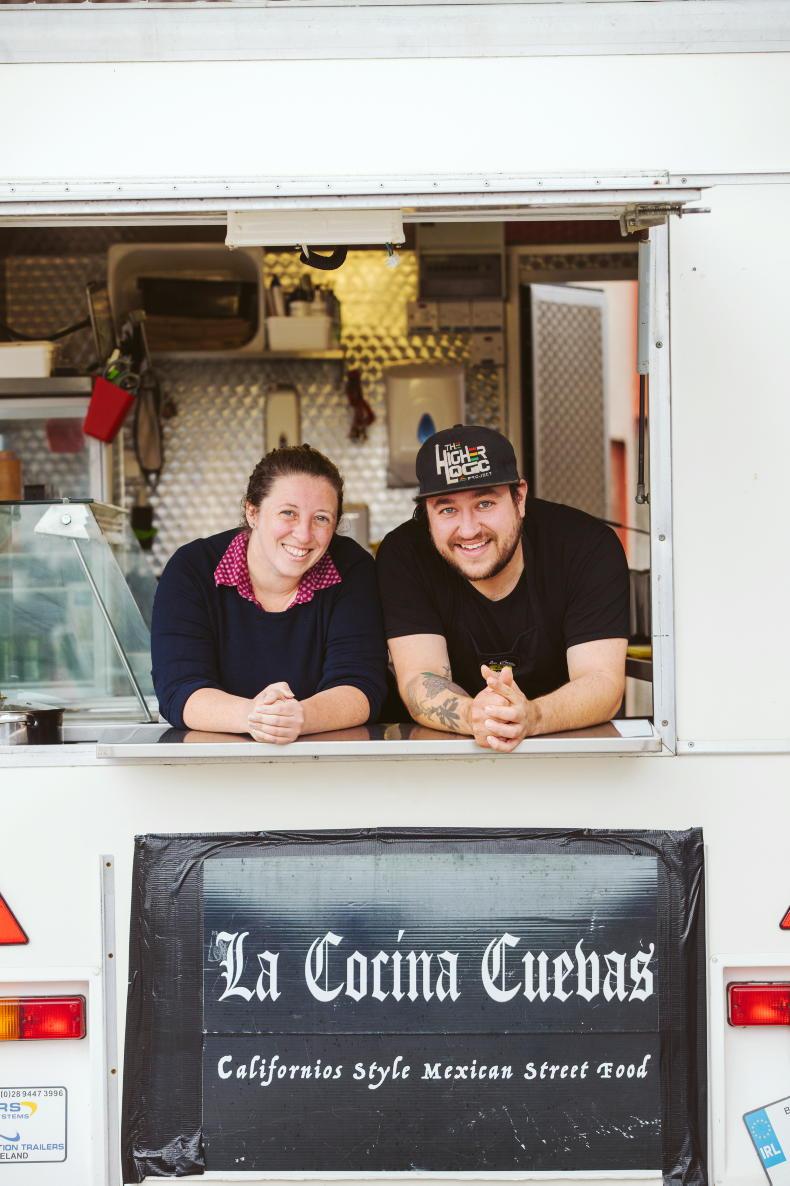
The food truck is based on Laura's family's farm in Naul, Co Dublin. \ Claire Nash
Peering ahead, I see nothing but a mix of farms, domestic homes and rolling hills.
“Just drive,” my friend instructs.
Sure enough, we soon come across a sandwich board sign on the side of the road. La Cocina Cuevas: California-style Mexican cuisine. As we drive up the lane (past some cute thatched-roof dog houses), we enter into a farmyard. Sheds have been converted to open-air seating pods and on the other end of the farmyard sits the food truck.
Happy accident
This happy accident leads to a fun, memorable lunch out with friends.
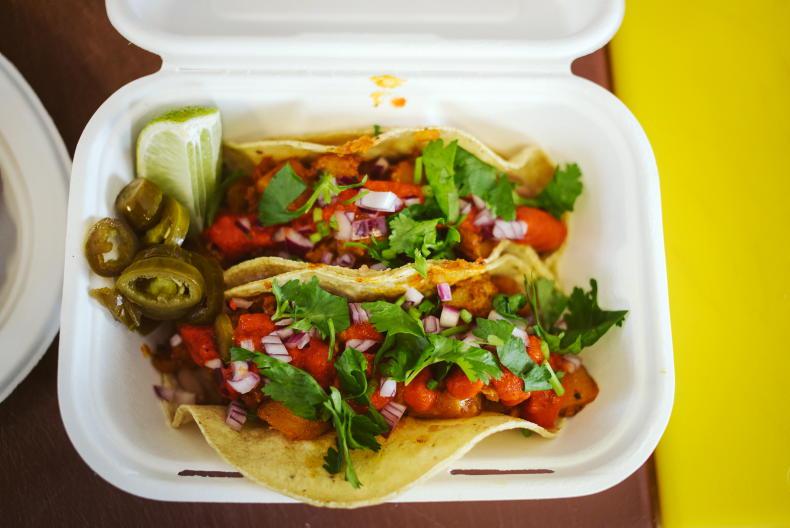
Jeremy says a lot of the food is inspired by his paternal grandparents who moved to the US from Mexico in the 1950s. \ Claire Nash
We feast on loaded tater tots (patatas fritas) with guacamole and spicy toppings. We order several types of tacos and drinks. I eat Birria beef tacos (slow-cooked beef dripping in sauce), which comes with a side of spicy consommé for dipping and some Korean chicken tacos.
This mix of flavours, cultures and ingredients is what sets Californian-style Mexican (or Cali-Mex) cuisine apart from its traditional Mexican or even Southwest American counterparts.
At the helm of the operation is Californian blow-in chef Jeremy Cuevas and his partner, Dublin native Laura Duffy.
Family farm
The farm itself belonged to Laura’s grandparents, who have now passed. When Laura and Jeremy moved to Naul from London, where they had been living and working, her father suggested they stay on the farm to mind the property.
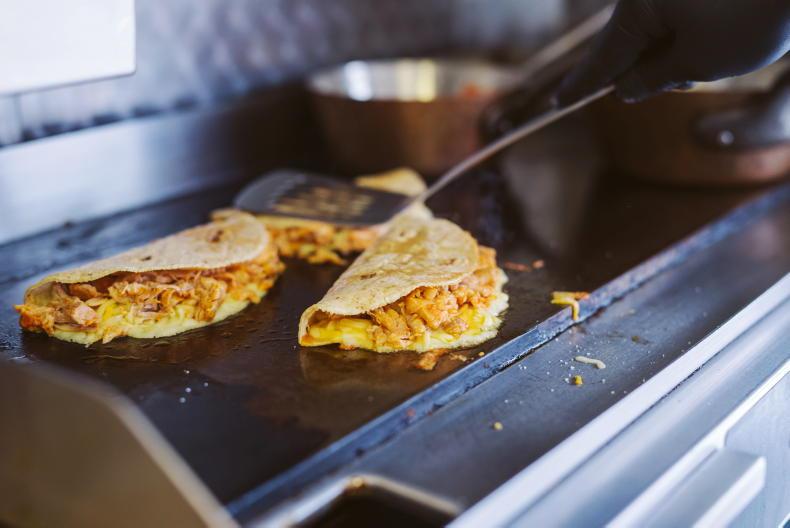
Tacos and quesadillas are staple items on the menu. \ Claire Nash
This was fortuitous not only in providing a roof over their heads but a space in which to conduct business safely once the pandemic hit. The farm, which no longer holds livestock, is ideal for social distancing and outdoor dining – the ambiance is family-friendly and laid back.
A few weeks after our surprise lunch, I return to Naul for a chat with the enterprising duo (and to eat more tacos). Jeremy, who earned a degree in food history before attending culinary school in England, says a lot of what he does at La Cocina Cuevos is inspired by his paternal grandparents who emigrated to the United States from Mexico in the late 1950s.
Agri-roots
“My grandmother had a Mexican restaurant called La Cocina Cuevas,” he says.
“I grew up in Lodi, which is in California’s Central Valley – it’s basically vineyards as far as you can see. My grandparents came over from Mexico on something called the Bracero Program, which I think was in the late 1950s or early ’60s.

Laura and Jeremy lived in London before moving to Naul, Co Dublin. \ Claire Nash
“It was a programme for migrant farm workers to legally come into the United States,” he continues. “You got a temporary visa but the loophole then was if you had a kid in the US you could stay. A few of my dad’s older siblings were born in Mexico but then my dad and the rest were all born in the US. But yeah, they were migrant farmers. They all had to go out and work in the fields.”
Life lessons
By the time Jeremy came along, his family lived a more comfortable life. 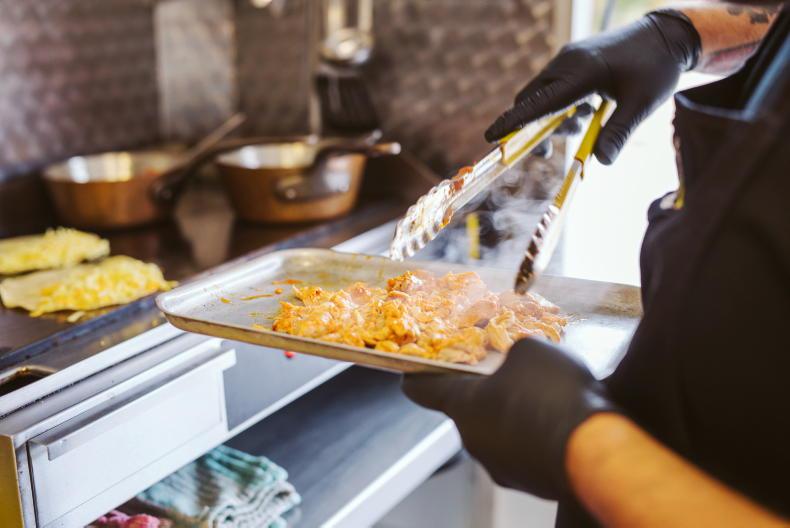
He attended good schools and lived in a nice neighbourhood. However, his father never missed an opportunity to remind Jeremy of his family’s agricultural roots.
“Once, when I was a teenager, we passed these strawberry fields on the way to school and I [jokingly said something] about migrant workers and [my dad] did not find it funny,” he sheepishly recalls. “He stopped the car and said: ‘Wait here.’ He went over to speak with the man in the field, came back and told me to move my backpack and get out.
“‘You do whatever this man says and I’ll be back to get you on Sunday,’ he said,” Jeremy continues. “So I got down on my hands and knees all day in the blazing heat, and all weekend I had to pick strawberries. Then, in the evening when the sun went down, we let down the hatch and had to sell the strawberries. By Sunday I was defeated. My dad asked me if I learned anything [from the experience] – I said: ‘Yes – I learned I’m very fortunate. And I love strawberries.’
“It was very humbling and I never looked at food the same way again,” he adds. “My father always said my family had to crawl across the border [for a better life]. He would say: ‘You need to appreciate what we’ve given you.’”
Career in food
These were life lessons Jeremy took along with him throughout his education and early career as a chef.
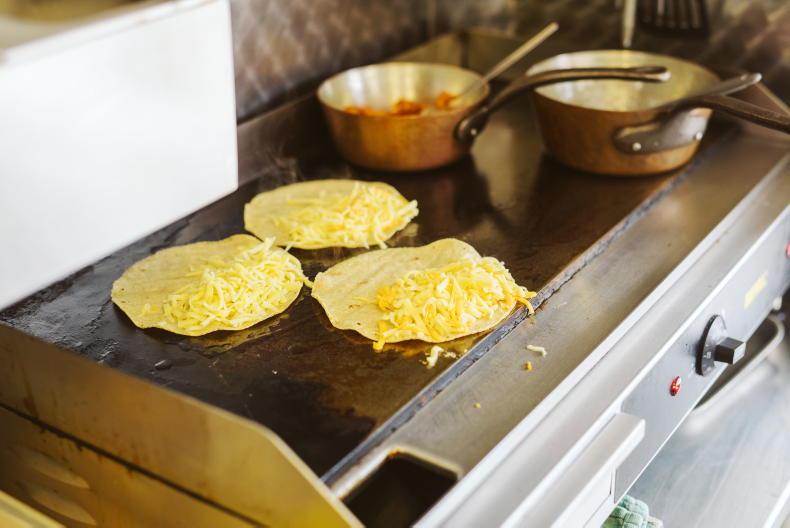
After university, he secured a stagier (unpaid internship) at the prestigious French Laundry near Napa, California, (at one time, The French Laundry was listed as the best restaurant in the world).
“They offered me a job after the stage was finished but I felt like I needed to learn more,” Jeremy explains. “I worked in a good restaurant in my hometown for one year to save money and learn. I worked under a pastry chef and actually really loved that experience. Then I made the move to England.”
Meeting of the minds
After working in some high-end restaurants in Amersham and London, Jeremy met Laura, who worked in fringe theatre and ran a fringe production company. In the evenings, she was a bartender in one of their favourite bars.
“After we’d been together for a bit, we were both really burnt out from London,” Jeremy says. “So Laura said, ‘Look, can we just do a year in Ireland to see if you’d like it?’ So we did. I went to work at Locks Brasserie in Portobello. I had a lot of fun there and made some really nice food.
“Laura and I decided to stay a while longer but do our own thing,” he continues. “So I worked part time for six months and, the rest of the time, I worked on starting this business. That was in 2019. Business had been good and these three years have gone by really fast. Our first year we did a lot of festivals and farmers markets and then, during the pandemic, we started serving at the side of the road [here in Naul] and it got really busy.”
Pandemic food truck life
Jeremy says that during the pandemic the gardaí had a checkpoint in Naul. When asking where people were going, they wouldn’t believe anyone when they’d say they were on their way to “the taco truck” or “the Mexican place”. Finally, one of Jeremy and Laura’s regulars told the gardaí to follow her to the farm.
“They came in and were like: ‘Oh sorry, we didn’t believe anybody. We didn’t know this was here,” Jeremy laughs.
New food experience
At first, many of the guests at La Cocina Cuevas weren’t familiar with California-style Mexican food – luckily, Laura has the unique ability to explain menu items from an Irish perspective.
“People didn’t really get the food at first,” Jeremy says. “At that stage, the menu was only written on the chalk board and I found myself having to write the full description of what each menu item was – then Laura was able to give people the descriptors and explain the flavours.”
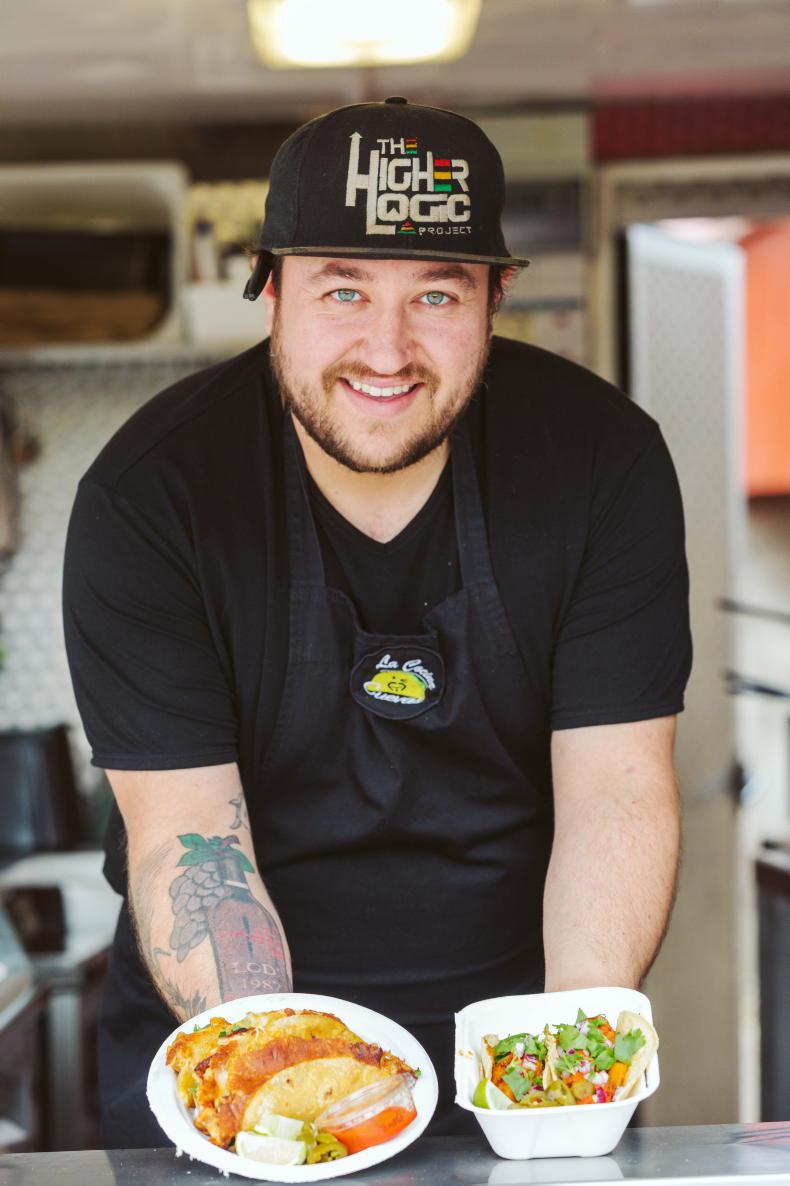
“Honestly,” Laura says, “I had to learn how to eat it too, so that helps when explaining it to others. For example, our salsa roja has no tomatoes in it (salsa roja literally translates to red sauce) – it’s made with red peppers, so it’s not what you’d normally find in Ireland. Lots of us have only been exposed to Old El Paso and that’s just not what we’re doing.”
What’s the difference?
But, ICL asks, what’s the difference between California-style Mexican food and other Mexican foods?
“Mexican food is so regional,” Jeremy says. “Look at California as an extension of Mexico – people from different parts of the country settled there and brought their own regional variations. Also, though, they had to come up with alternatives to their former local ingredients – like monterey jack cheese, for example, you wouldn’t find that in Mexico.
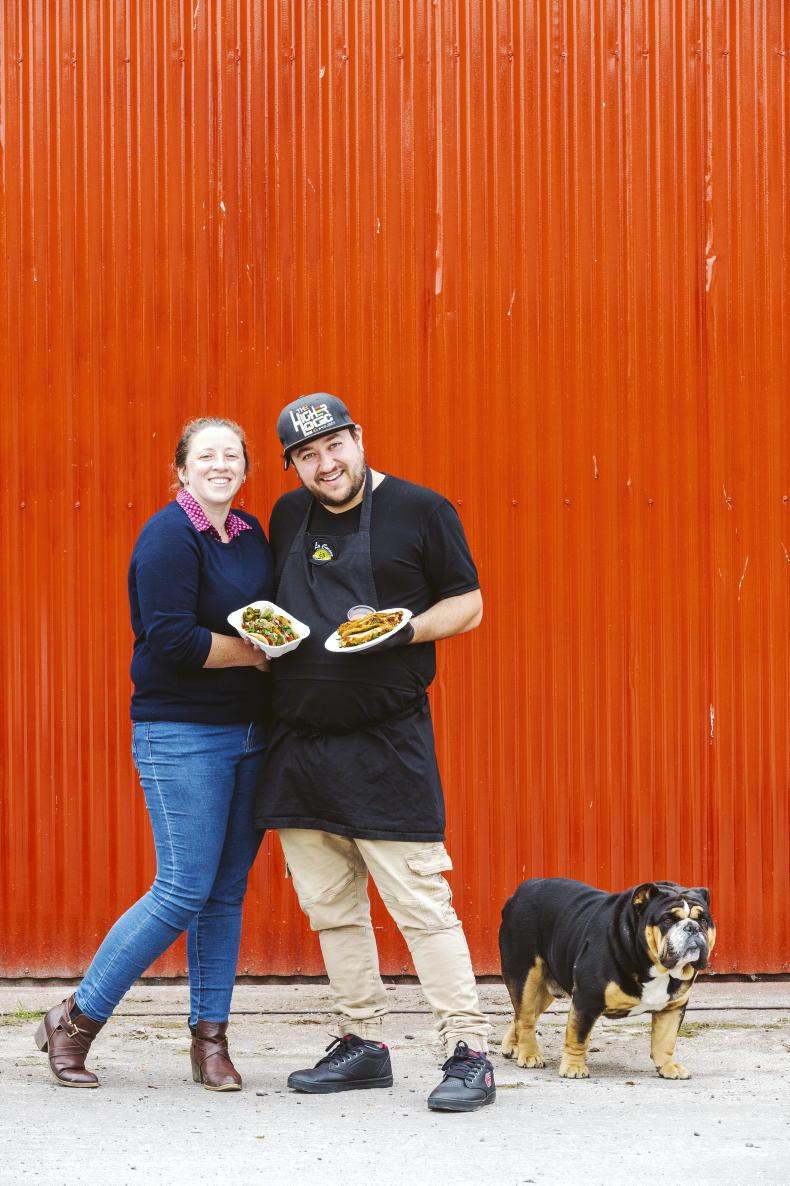
“When we label our food as California-style Mexican, it gives me a lot of freedom,” he adds, “because Cali-style food is such a melting pot of flavour and culture.”
Jeremy makes a lot of his ingredients in-house, including breads and cheese (“Why wouldn’t you make your own queso fresco when Irish milk is so good?”) and they source most of their ingredients locally. They prepare their weekly menu offerings in an industrial prep kitchen in Co Meath (25 minutes’ away), which gives Jeremy the quality control he needs with different locations and catering jobs on the go.
Plans for the future
The couple have plans to expand their business but in a sustainable way. 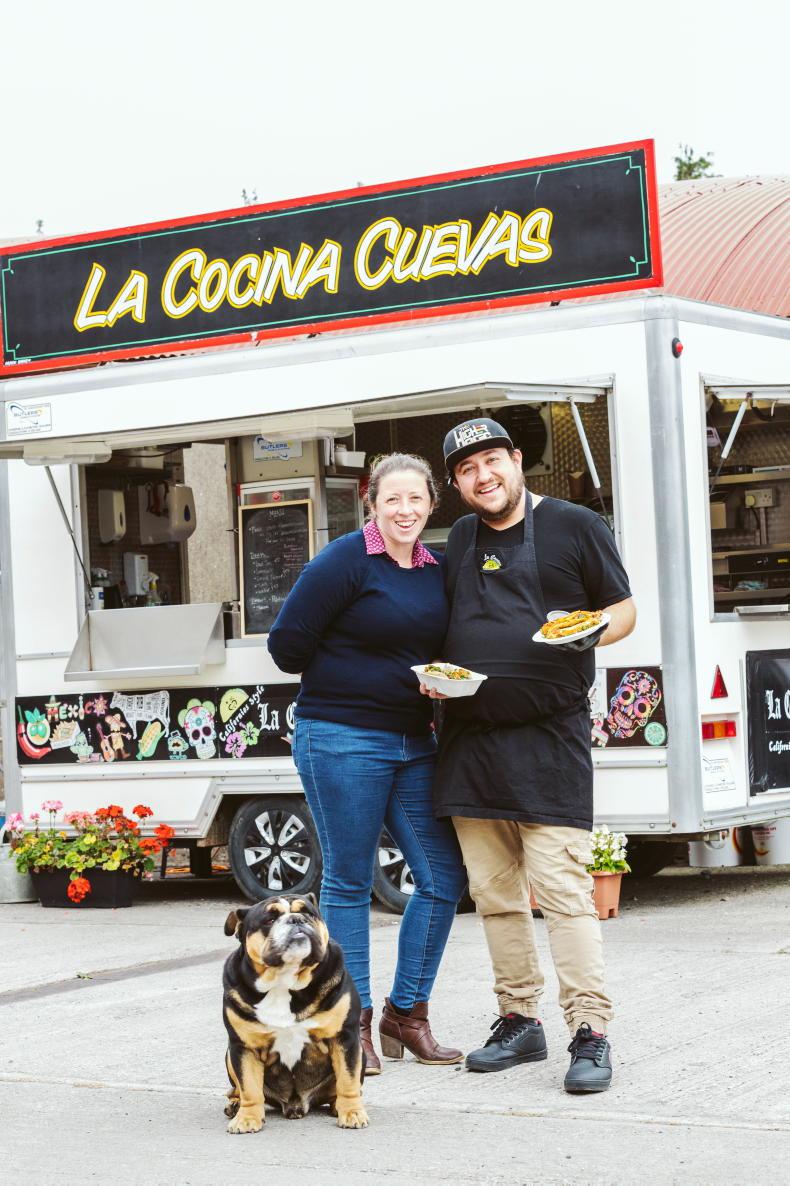
While they love the casual, fun, family-friendly atmosphere at their farmhouse food truck, Jeremy also has a high-end culinary skillset which isn’t currently being put to use. Laura says they hope to create a food experience in one of their fields in the coming months by building an eco-lodge of sorts.
“From the top field, you have the most beautiful view of Dublin,” she says. “I really feel Jeremy can put his full skillset to use [in this kind of setting] and we can create something really special.”
lacocinacuevas.com
Read more
Bird in the kitchen
All you need is Grá
“I’m starving,” I complain to my friends. I was driving a few of us to Naul, Co Dublin, from our home base in Tipperary. One friend is planning her wedding and wanted to meet with a dressmaker there.
Her appointment timing meant we couldn’t stop along the way for lunch and now we were all ravenous – but it didn’t look like there was anywhere to eat in the village.
A quick Google search ensued and someone in the back piped up: “There’s a taco truck just up the road.”

The food truck is based on Laura's family's farm in Naul, Co Dublin. \ Claire Nash
Peering ahead, I see nothing but a mix of farms, domestic homes and rolling hills.
“Just drive,” my friend instructs.
Sure enough, we soon come across a sandwich board sign on the side of the road. La Cocina Cuevas: California-style Mexican cuisine. As we drive up the lane (past some cute thatched-roof dog houses), we enter into a farmyard. Sheds have been converted to open-air seating pods and on the other end of the farmyard sits the food truck.
Happy accident
This happy accident leads to a fun, memorable lunch out with friends.

Jeremy says a lot of the food is inspired by his paternal grandparents who moved to the US from Mexico in the 1950s. \ Claire Nash
We feast on loaded tater tots (patatas fritas) with guacamole and spicy toppings. We order several types of tacos and drinks. I eat Birria beef tacos (slow-cooked beef dripping in sauce), which comes with a side of spicy consommé for dipping and some Korean chicken tacos.
This mix of flavours, cultures and ingredients is what sets Californian-style Mexican (or Cali-Mex) cuisine apart from its traditional Mexican or even Southwest American counterparts.
At the helm of the operation is Californian blow-in chef Jeremy Cuevas and his partner, Dublin native Laura Duffy.
Family farm
The farm itself belonged to Laura’s grandparents, who have now passed. When Laura and Jeremy moved to Naul from London, where they had been living and working, her father suggested they stay on the farm to mind the property.

Tacos and quesadillas are staple items on the menu. \ Claire Nash
This was fortuitous not only in providing a roof over their heads but a space in which to conduct business safely once the pandemic hit. The farm, which no longer holds livestock, is ideal for social distancing and outdoor dining – the ambiance is family-friendly and laid back.
A few weeks after our surprise lunch, I return to Naul for a chat with the enterprising duo (and to eat more tacos). Jeremy, who earned a degree in food history before attending culinary school in England, says a lot of what he does at La Cocina Cuevos is inspired by his paternal grandparents who emigrated to the United States from Mexico in the late 1950s.
Agri-roots
“My grandmother had a Mexican restaurant called La Cocina Cuevas,” he says.
“I grew up in Lodi, which is in California’s Central Valley – it’s basically vineyards as far as you can see. My grandparents came over from Mexico on something called the Bracero Program, which I think was in the late 1950s or early ’60s.

Laura and Jeremy lived in London before moving to Naul, Co Dublin. \ Claire Nash
“It was a programme for migrant farm workers to legally come into the United States,” he continues. “You got a temporary visa but the loophole then was if you had a kid in the US you could stay. A few of my dad’s older siblings were born in Mexico but then my dad and the rest were all born in the US. But yeah, they were migrant farmers. They all had to go out and work in the fields.”
Life lessons
By the time Jeremy came along, his family lived a more comfortable life. 
He attended good schools and lived in a nice neighbourhood. However, his father never missed an opportunity to remind Jeremy of his family’s agricultural roots.
“Once, when I was a teenager, we passed these strawberry fields on the way to school and I [jokingly said something] about migrant workers and [my dad] did not find it funny,” he sheepishly recalls. “He stopped the car and said: ‘Wait here.’ He went over to speak with the man in the field, came back and told me to move my backpack and get out.
“‘You do whatever this man says and I’ll be back to get you on Sunday,’ he said,” Jeremy continues. “So I got down on my hands and knees all day in the blazing heat, and all weekend I had to pick strawberries. Then, in the evening when the sun went down, we let down the hatch and had to sell the strawberries. By Sunday I was defeated. My dad asked me if I learned anything [from the experience] – I said: ‘Yes – I learned I’m very fortunate. And I love strawberries.’
“It was very humbling and I never looked at food the same way again,” he adds. “My father always said my family had to crawl across the border [for a better life]. He would say: ‘You need to appreciate what we’ve given you.’”
Career in food
These were life lessons Jeremy took along with him throughout his education and early career as a chef.

After university, he secured a stagier (unpaid internship) at the prestigious French Laundry near Napa, California, (at one time, The French Laundry was listed as the best restaurant in the world).
“They offered me a job after the stage was finished but I felt like I needed to learn more,” Jeremy explains. “I worked in a good restaurant in my hometown for one year to save money and learn. I worked under a pastry chef and actually really loved that experience. Then I made the move to England.”
Meeting of the minds
After working in some high-end restaurants in Amersham and London, Jeremy met Laura, who worked in fringe theatre and ran a fringe production company. In the evenings, she was a bartender in one of their favourite bars.
“After we’d been together for a bit, we were both really burnt out from London,” Jeremy says. “So Laura said, ‘Look, can we just do a year in Ireland to see if you’d like it?’ So we did. I went to work at Locks Brasserie in Portobello. I had a lot of fun there and made some really nice food.
“Laura and I decided to stay a while longer but do our own thing,” he continues. “So I worked part time for six months and, the rest of the time, I worked on starting this business. That was in 2019. Business had been good and these three years have gone by really fast. Our first year we did a lot of festivals and farmers markets and then, during the pandemic, we started serving at the side of the road [here in Naul] and it got really busy.”
Pandemic food truck life
Jeremy says that during the pandemic the gardaí had a checkpoint in Naul. When asking where people were going, they wouldn’t believe anyone when they’d say they were on their way to “the taco truck” or “the Mexican place”. Finally, one of Jeremy and Laura’s regulars told the gardaí to follow her to the farm.
“They came in and were like: ‘Oh sorry, we didn’t believe anybody. We didn’t know this was here,” Jeremy laughs.
New food experience
At first, many of the guests at La Cocina Cuevas weren’t familiar with California-style Mexican food – luckily, Laura has the unique ability to explain menu items from an Irish perspective.
“People didn’t really get the food at first,” Jeremy says. “At that stage, the menu was only written on the chalk board and I found myself having to write the full description of what each menu item was – then Laura was able to give people the descriptors and explain the flavours.”

“Honestly,” Laura says, “I had to learn how to eat it too, so that helps when explaining it to others. For example, our salsa roja has no tomatoes in it (salsa roja literally translates to red sauce) – it’s made with red peppers, so it’s not what you’d normally find in Ireland. Lots of us have only been exposed to Old El Paso and that’s just not what we’re doing.”
What’s the difference?
But, ICL asks, what’s the difference between California-style Mexican food and other Mexican foods?
“Mexican food is so regional,” Jeremy says. “Look at California as an extension of Mexico – people from different parts of the country settled there and brought their own regional variations. Also, though, they had to come up with alternatives to their former local ingredients – like monterey jack cheese, for example, you wouldn’t find that in Mexico.

“When we label our food as California-style Mexican, it gives me a lot of freedom,” he adds, “because Cali-style food is such a melting pot of flavour and culture.”
Jeremy makes a lot of his ingredients in-house, including breads and cheese (“Why wouldn’t you make your own queso fresco when Irish milk is so good?”) and they source most of their ingredients locally. They prepare their weekly menu offerings in an industrial prep kitchen in Co Meath (25 minutes’ away), which gives Jeremy the quality control he needs with different locations and catering jobs on the go.
Plans for the future
The couple have plans to expand their business but in a sustainable way. 
While they love the casual, fun, family-friendly atmosphere at their farmhouse food truck, Jeremy also has a high-end culinary skillset which isn’t currently being put to use. Laura says they hope to create a food experience in one of their fields in the coming months by building an eco-lodge of sorts.
“From the top field, you have the most beautiful view of Dublin,” she says. “I really feel Jeremy can put his full skillset to use [in this kind of setting] and we can create something really special.”
lacocinacuevas.com
Read more
Bird in the kitchen
All you need is Grá
















 This is a subscriber-only article
This is a subscriber-only article









SHARING OPTIONS: